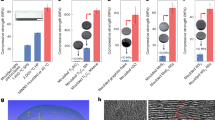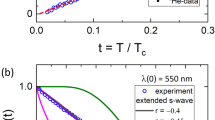Abstract
Although Portland cement concrete is the world’s most widely used manufactured material, basic questions persist regarding its internal structure and water content, and their effect on concrete behaviour. Here, for the first time without recourse to drying methods, we measure the composition and solid density of the principal binding reaction product of cement hydration, calcium–silicate–hydrate (C–S–H) gel, one of the most complex of all gels. We also quantify a nanoscale calcium hydroxide phase that coexists with C–S–H gel. By combining small-angle neutron and X-ray scattering data, and by exploiting the hydrogen/deuterium neutron isotope effect both in water and methanol, we determine the mean formula and mass density of the nanoscale C–S–H gel particles in hydrating cement. We show that the formula, (CaO)1.7(SiO2)(H2O)1.80, and density, 2.604 Mg m−3, differ from previous values for C–S–H gel, associated with specific drying conditions. Whereas previous studies have classified water within C–S–H gel by how tightly it is bound, in this study we classify water by its location—with implications for defining the chemically active (C–S–H) surface area within cement, and for predicting concrete properties.
This is a preview of subscription content, access via your institution
Access options
Subscribe to this journal
Receive 12 print issues and online access
$259.00 per year
only $21.58 per issue
Buy this article
- Purchase on Springer Link
- Instant access to full article PDF
Prices may be subject to local taxes which are calculated during checkout





Similar content being viewed by others
References
Le Chatelier, H. L. Experimental Researches on the Constitution of Hydraulic Mortars (McGraw, New York, 1905).
Taylor, H. F. W. Cement Chemistry 2nd edn (Thomas Telford, London, 1997).
Acker, P. in Creep, Shrinkage, and Durability Mechanics of Concrete and Other Quasi-Brittle Materials (eds Ulm, F. J., Bazant, Z. P. & Wittmann, F. H.) (Elsevier Science, New York, 2001).
Scherer, G. W. Structure and properties of gels. Cement Concrete Res. 29, 1149–1157 (1999).
Pijaudier-Cabot, G., Gerard, B. & Acker, P. (eds) in Proc. 7th Int. Conf. on Creep, Shrinkage, and Durability of Concrete and Concrete Structures (Hermes Science, London, 2005).
Bazant, Z., Cusatis, G. & Cedolin, L. Temperature effect on concrete creep modeled by microprestress-solidification theory. J. Eng. Mech. 130, 691–699 (2004).
Richardson, I. G. The nature of C–S–H in hardened cement pastes. Cement Concrete Res. 29, 1131–1147 (1999).
Gaboriaud, F., Nonat, A., Chaumont, D., Craievich, A. & Hanquet, B. Si-29 NMR and small-angle X-ray scattering studies of the effect of alkaline ions (Li+,Na+, and K+) in silico-alkaline sols. J. Phys. Chem. B 103, 2091–2099 (1999).
Papavassiliou, G. et al. Role of the surface morphology in cement gel growth dynamics: A combined nuclear magnetic resonance and atomic force microscopy study. J. Appl. Phys. 82, 449–452 (1997).
Cong, X. & Kirkpatrick, R. J. 29Si MAS NMR study of the structure of calcium silicate hydrate. Adv. Cement Based Mater. 3, 144–156 (1994).
Winslow, D. N. & Diamond, S. Specific surface of hardened cement paste as determined by small-angle X-ray scattering. J. Am. Ceram. Soc. 57, 193–197 (1974).
Volkl, J. J., Beddoe, R. E. & Setzer, M. J. The specific surface of hardened cement paste by small-angle X-ray-scattering effect of moisture-content and chlorides. Cement Concrete Res. 17, 81–88 (1987).
Yang, R. H., Liu, B. Y. & Wu, Z. W. Study on the pore structure of hardened cement paste by SAXS. Cement Concrete Res. 20, 385–393 (1990).
Winslow, D., Bukowski, J. M. & Young, J. F. The early evolution of the surface of hydrating cement. Cement Concrete Res. 24, 1025–1032 (1994).
Beddoe, R. E. & Lang, K. Effect of moisture on fractal dimension and specific surface of hardened cement paste by small-angle X-ray-scattering. Cement Concrete Res. 24, 605–612 (1994).
Winslow, D., Bukowski, J. M. & Young, J. F. The fractal arrangement of hydrated cement paste. Cement Concrete Res. 25, 147–156 (1995).
Thomas, J. J., Jennings, H. M. & Allen, A. J. The surface area of hardened cement paste as measured by various techniques. Concrete Sci. Eng. 1, 45–64 (1999).
Vollet, D. R. & Craievich, A. F. Effects of temperature and of the addition of accelerating and retarding agents on the kinetics of hydration of tricalcium silicate. J. Phys. Chem. B 104, 12143–12148 (2000).
Allen, A. J. et al. A small-angle scattering study of cement porosities. J. Phys. D 15, 1817–1833 (1982).
Pearson, D., Allen, A. J., Windsor, C. G., Alford, N. McN. & Double, D. D. An investigation on the nature of porosity in hardened cement pastes using small-angle neutron scattering. J. Mater. Sci. 18, 430–438 (1983).
Pearson, D. & Allen, A. J. A study of ultrafine porosity in hydrated cements using small-angle neutron scattering. J. Mater. Sci. 20, 303–315 (1985).
Allen, A. J., Oberthur, R. C., Pearson, D., Schofield, P. & Wilding, C. R. Development of the fine porosity and gel structure of hydrating cement systems. Phil. Mag. B 56, 263–288 (1987).
Haussler, F., Eichhorn, F., Rohling, S. & Baumbach, H. Monitoring of the hydration process of hardening cement pastes by small-angle neutron scattering. Cement Concrete Res. 20, 644–654 (1990).
Castano, V. M., Schmidt, P. W. & Hornis, H. G. Small-angle scattering studies of the pore structure of polymer-modified portland cement pastes. J. Mater. Res. 5, 1281–1284 (1990).
Allen, A. J. Time-resolved phenomena in cements, clays and porous rocks. J. Appl. Cryst. 24, 624–634 (1991).
Eichhorn, F., Haussler, F. & Baumbach, H. Structural studies on hydrating cement pastes. J. Phys. IV 3, 369–372 (1993).
Adenot, F., Auvray, L. & Touray, J. C. Determination of the fractal dimension of CSH aggregates (hydrated calcium silicates) of different origins and compositions — consequences for studies of cement paste durability. C. R. Acad. Sci. II 317, 185–189 (1993).
Janik, J. A., Kurdowski, W., Podsiadly, R. & Samseth, J. Studies of fractal aspects of cement. Acta Phys. Pol. A 90, 1179–1184 (1996).
Haussler, F., Hempel, M. & Baumbach, H. Long-time monitoring of the microstructural change in hardening cement paste by SANS. Adv. Cement Res. 9, 139–147 (1997).
Allen, A. J. & Livingston, R. A. Relationship between differences in silica fume additives and fine scale microstructural evolution in cement based materials. Adv. Cement Based Mater. 8, 118–131 (1998).
Thomas, J. J., Jennings, H. M. & Allen, A. J. The surface area of cement paste as measured by neutron scattering — evidence for two C–S–H morphologies. Cement Concrete Res. 28, 897–905 (1998).
Heinemann, A. et al. Fractal microstructures in hydrating cement paste. J. Mater. Sci. Lett. 18, 1413–1416 (1999).
Heinemann, A., Hermann, H. & Haussler, F. SANS analysis of fractal microstructures in hydrating cement paste. Physica B 276, 892–893 (2000).
Thomas, J. J., Chen, J. J., Allen, A. J. & Jennings, H. M. Effects of decalcification on the microstructure and surface area of cement and tricalcium silicate pastes. Cement Concrete Res. 34, 2297–2307 (2004).
Thomas, J. J., Jennings, H. M. & Allen, A. J. Determination of the neutron scattering contrast of hydrated portland cement paste using H2O/D2O exchange. Adv. Cement Based Mater. 7, 119–122 (1998).
Richardson, I. G. Tobermorite/jennite- and tobermorite/calcium hydroxide-based models for the structure of C–S–H: Applicability to hardened pastes of tricalcium silicate, beta-dicalcium silicate, portland cement, and blends of portland cement with blast-fumace slag, metakaolin, or silica fume. Cement Concrete Res. 34, 1733–1777 (2004).
Porod, G. in Small-Angle X-ray Scattering (eds Glatter, O. & Kratky, O.) (Academic, London, 1982).
Sears, V. F. Neutron scattering lengths and cross sections. Neutron News 3.3, 29–37 (1992).
Allison, S. K., Fox, J. P., Hargreaves, R. & Bates, S. P. Clustering and microimmiscibility in alcohol-water mixtures: Evidence from molecular-dynamics simulations. Phys. Rev. B 71, 024201 (2005).
Chantler, C. T. et al. X-ray form factor, attenuation and scattering tables (version 2. 1). (National Institute of Standards and Technology, Gaithersburg, 2005) Available online at: http://physics.nist.gov/ffast.
Brouwers, H. J. H. The work of Powers and Brownyard revisited: Part 1. Cement Concrete Res. 34, 1697–1716 (2004);ibid Part 2 Cement Concrete Res. 35, 1922–1936 (2005).
Potton, J. A., Daniell, G. J. & Rainford, B. D. Particle-size distributions from SANS data using the maximum-entropy method. J. Appl. Cryst. 21, 663–668 (1988).
Kirkpatrick, R. J., Kalinichev, A. G., Hou, X. & Struble, L. Experimental and molecular dynamics modeling studies of interlayer swelling: Water incorporation in kanemite and ASR gel. Mater. Struct. 38, 449–458 (2005).
Glinka, C. J. et al. The 30 m small-angle neutron scattering instruments at the National Institute of Standards and Technology. J. Appl. Cryst. 31, 430–445 (1998).
Barker, J. G. et al. Design and performance of a thermal-neutron double-crystal diffractometer for USANS at NIST. J. Appl. Cryst. 38, 1004–1011 (2005).
Ilavsky, J., Jemian, P. R., Allen, A. J. & Long, G. G. Versatile USAXS (Bonse-Hart) facility for advanced materials research. AIP Conf. Proc. 705, 510–513 (2004).
Acknowledgements
Thanks to C. Glinka, B. Hammouda, J. Barker, J. Ilavsky, P. R. Jemian and R. A. Livingston for scientific/technical support. Research at Northwestern University was supported by NSF grant CMS-0409571. SANS measurements are partly based on activities supported by NSF agreement DMR-9122444. The Advanced Photon Source is supported by US DoE, Office of Science contract W-31-109-ENG-38.
Author information
Authors and Affiliations
Corresponding author
Ethics declarations
Competing interests
The authors declare no competing financial interests.
Supplementary information
Supplementary Information
Supplementary information and table S1 (PDF 156 kb)
Rights and permissions
About this article
Cite this article
Allen, A., Thomas, J. & Jennings, H. Composition and density of nanoscale calcium–silicate–hydrate in cement. Nature Mater 6, 311–316 (2007). https://doi.org/10.1038/nmat1871
Received:
Accepted:
Published:
Issue Date:
DOI: https://doi.org/10.1038/nmat1871
This article is cited by
-
Molecular dynamics study of the mechanical properties of hydrated calcium silicate enhanced by functionalized carbon nanotubes
Journal of Molecular Modeling (2024)
-
A fully coupled Hydraulic Mechanical Chemical approach applied to cementitious material damage due to carbonation
npj Materials Degradation (2023)
-
4D nanoimaging of early age cement hydration
Nature Communications (2023)
-
Effect of nickel-coated carbon nanotubes on the tensile behaviors of ultra-high performance concrete (UHPC): insights from experiments and molecular dynamic simulations
Journal of Materials Science (2023)
-
Electromagnetic properties of cement paste after microwave pretreatment
Archives of Civil and Mechanical Engineering (2023)



